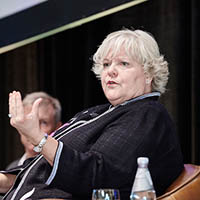Technology is a powerful differentiator for enterprise companies today. Innovative tools can quickly set teams apart from their peers and sustain them in an increasingly complex and competitive environment. Cyber risk, digitization and innovation continually threaten to disrupt long established companies in favor of teams with more modern systems.
So it’s a surprise that as technology becomes embedded in nearly every facet of a business, seasoned IT executives and chief information officers (CIOs) are still missing at the highest levels of corporate leadership — the boardroom. According to a recent Deloitte study, just 5% of S&P 500 companies appointed a technologist to an open board seat (despite the fact that high-performing S&P 500 companies were 31% more likely to have a tech-savvy board director).
Why the gap? That was one of the topics we explored at Sapphire Ventures’ 2019 CIO Summit where we dug into the topic of CIOs on boards through presentations, panel discussions, and informal conversations. We discussed the perceptual barriers that CIOs often face when seeking public- or private-company director roles and brainstormed ways that CIOs can showcase their differentiated value as independent directors, nail the interview, and position a company at the front lines of innovation. Read on for five key takeaways.
1. Understand how boards have changed — and what they’re looking for today.
Corporate boards have the reputation of being homogenous and traditional with their business practices, yet that’s changing today. As Tuck Rickards, managing director at Russell Reynolds Associates and leader of the firm’s Digital Transformation Practice, described at the Summit:
“Boards no longer seek members who look like them and are from similar backgrounds. Today, a board is looking more like an agile scrum.”
(For those unfamiliar with the term, Atlassian defines a scrum as a framework for “diverse teams learning through experiences, self-organizing while working on a problem, and reflecting on their wins and losses to continuously improve.”)
Boards today understand that bringing leaders together from different professional and personal backgrounds leads to a richer decision-making process, a stronger reputation among the company’s customers and employees, and even, according to recent data from McKinsey, better financial returns. In addition, institutional investors are pushing for diversity in many forms, including functional expertise.
As a transformational leader and CIO, it’s an excellent time to align with a find a board that is seeking fluency in emerging and innovative technology.
2. Identify and fill your knowledge gaps.
Despite demand, as a CIO looking for a board seat, it’s not enough to be an expert on business software. As Patty Morrison (former CIO, Cardinal Health, and five-time public-company director) noted at the CIO Summit, tech leaders must bring a lot more business savvy to the table — from understanding revenue recognition standards (if they serve on the audit committee) to managing risk to meeting shareholder demands and even acting swiftly and effectively during a major event (e.g., bankruptcy, merger, or IPO) — to secure their position.
While your tech experience will be a valuable asset in all of these discussions, it’s important to educate yourself broadly in areas of business where you’re less comfortable. At Sapphire Ventures we’ve started compiling a range of resources to help CIOs become board-ready. For example, our ongoing event series brings together career coaches and recruiters, current and former CIOs, and public- and private-company board members to help support, inform, and connect technology leaders as they take the next step into board service.
Attending events like this and seeking other forms of continuing education will help you understand the right questions to ask and will teach you how to speak the language of corporate boards. Being able to clearly describe issues like technical debt or a botched data migration and then suggest solutions through the lens of ROI, revenue and churn metrics, valuation multiples, and risk will showcase your strengths.
3. Let people know you’re looking for a board seat.
Half of board appointments go through global executive search firms, and another 50% happen through friends and family, so it is critical to communicate your interest. Are you answering calls from retained search firms? Are you activating your network?
To ensure that you’re top of mind as boards plan for succession, reach out to specialized retained search firms like Russell Reynolds Associates (public boards), as well as heads of talent at VC firms (for venture-backed, privately held company boards). If you work within a specific industry, such as health care, do your research to figure out which firms specialize in your field (e.g., Oxeon Partners). Affinity groups like Beyond Board, Him for Her, or the Athena Alliance (for women) can also support you and provide greater visibility. In addition, don’t be shy about connecting with CEOs, mentors, and with current directors in your network. “Boarded up” directors who don’t have room for another board commitment may be open to referring you when they are approached.
Finally, make sure your board bio represents your highest level of impact as a technically savvy, confident, and networked steward of your business. Candidates who reach the interview stage will have extensive management and industry experience; however, to make the final cut, you need to convey emotional intelligence, unshakeable ethics, and the ability to work effectively in a team. Tuck Rickards reminded the CIO Summit audience to “steer clear of signaling that you’re a single-issue director.” Instead, show how you can participate and debate at multiple levels to make the entire board stronger.
4. Tell your unique, authentic story.
As Juergen Mueller, CTO and executive board member, SAP, noted at the CIO Summit:
CIOs must be change agents. While they should be proud of keeping the IT machine running, they also need to expand and pursue partnerships with other division heads, such as HR. Successful CIOs will ensure they’re relevant in the future.
For CIOs looking to level-up their career, being able to clearly articulate how they transform companies — instead of maintain the status quo — is essential. In a prior Sapphire Ventures event on board readiness, executive coach and multi-time CMO Ben Kiker shared how to:
- Express your superpower (a talent that’s all your own). This might be, “I consistently reduce cyber risk in an increasingly dangerous environment by bringing in cost-effective and easy-to-implement threat detection tools.” Once you identify your superpower, lead with it.
- Articulate your process (how you bring your superpower to life). For an IT leader, this could be through creating a balanced vendor portfolio to support your in-house team or identifying and working with startups that deliver greater ROI. Articulating your process in an action-focused way will help a board understand how you will close gaps at their company.
- Name your active ingredient (your essence or core nature). Each of us has an active ingredient — but it will not be the same for everyone. For a CIO this might be explaining technical concepts to nontechnical teammates. When you find a company that values your active ingredient, you (and the entire company) will thrive.
Including specific anecdotes, success metrics, and professional references in your story will make it even more substantial — and actionable for those who interview you.
5. Know when to say no.
In the end, you won’t be a successful corporate director if you can’t devote the time to it. As Patty Morrison reminded us:
Being on a board is not a minor commitment. Four directorships can equal a full-time job — and during major events, such as activist bid or merger (which often happens during a 10-year tenure), this can go up considerably.
Because of these requirements, it’s also important to be passionate about a company’s product before you dive in. You won’t be motivated to serve on subcommittees, dig in on strategic issues, and work closely with other board members and executives if your heart isn’t in it.
So be honest with yourself about your capacity and your compensation requirements (especially if you’re currently working full time), be wise about your offers, and don’t rush into service unless it’s a good fit.
Take the Next Step
Barriers remain — yet it’s an excellent time for CIOs to take their career (and company) to the next level. One of the key findings from Sapphire Ventures 2019 CIO Innovation Index — first released at Sapphire’s 2019 CIO Summit — is that CIOs and IT executives are already increasing their engagement with corporate boards, specifically with regard to emerging technologies. As new tools and ways of working become increasingly central to corporate strategy, boards will need more support in making decisions on complex issues like cybersecurity, data privacy, and digital transformation. Today nearly three-quarters of CIOs are engaging their company’s board on these issues on at least a quarterly basis. The next step is full representation — and Sapphire is here to support CIOs in making the move.







